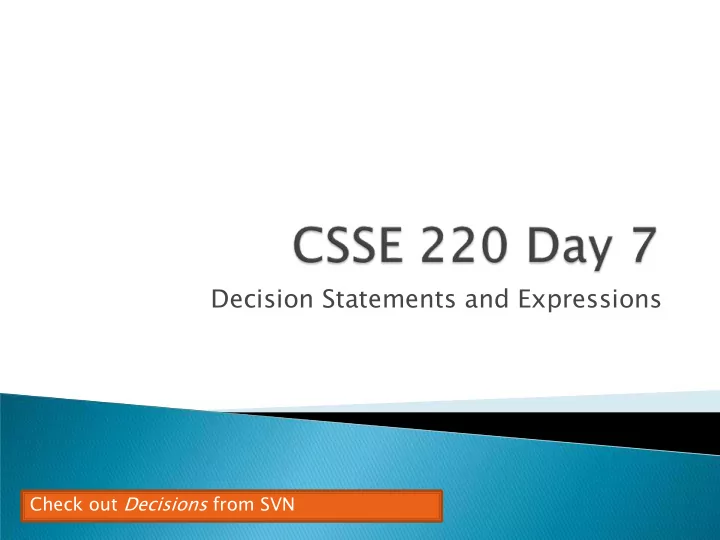

Decision Statements and Expressions Check out Decisions from SVN
Quick review of if statements == vs. equals() Selection operator, ? : switch and enumerations
int letterCount = 0; int upperCaseCount = 0; String switchedCase = ""; for (int i = 0; i < message.length(); i++) { char nextChar = message.charAt(i); if (Character.isLetter(nextChar)) { letterCount++; } if (Character.isUpperCase(nextChar)) { upperCaseCount++; switchedCase += Character.toLowerCase(nextChar); } else if (Character.isLowerCase(nextChar)){ switchedCase += Character.toUpperCase(nextChar); } else { switchedCase += nextChar; } }
Exercise: EmailValidator ◦ Use a Scanner object ◦ Prompt for user’s email address ◦ Prompt for it again ◦ Compare the two entries and report whether or not they match Notice anything strange?
In Java: ◦ o1 == o2 compares values ◦ o1.equals(o2) compares objects Remember: variables of class type store refere erence values How should you compare the email addresses in the exercise? Q1
Statements: used only for their side effects ◦ Changes they make to stored values or control flow Expressions: calculate values Many statements contain expressions: ◦ if (amount <= balance) { balance = balance – amount; } else { balance = balance – OVERDRAFT_FEE; }
Let’s us choose between two possible values for an expression Example: ◦ balance = balance – (amount <= balance) ? amount : OVERDRAFT_FEE Also called “ternary” operator (Why?) Q2
Can switch on char grade = … integer, character, int points; or “enumerated switch (grade) { constant” case „A‟: points = 95; break; case „B‟: points = 85; Don’t forget the breaks! break; … default: points = 0; Q3 }
Let us specify Then switch on named sets of them: values: public String colorOf(Suit s) { public enum Suit { switch (s) { CLUBS, case CLUBS: SPADES, case SPADES: DIAMONDS, return “black”; HEARTS default: } return “red”; } }
Implement a class Bid ◦ Constructor should take a “trump” Suit and an integer representing a number of “tricks” ◦ Test and implement a method, getValue(), that returns the point value of the bid, or 0 if the bid isn’t legal. See table for values of the legal bids. Spades Clubs Diamonds ds Hearts ts No Trump 6 tricks 40 60 80 100 120 7 tricks 140 160 180 200 220 8 tricks 240 260 280 300 320 9 tricks 340 360 380 400 420 10 tricks 440 460 480 500 520
Comparison operators: < , <= , > , >= , != , == Comparing objects: equals() , compareTo() Boolean operators: ◦ and: && ◦ or: || ◦ not: ! Q4
A common pattern in Java: public boolean isFoo() { … // return true or false depending on // the Foo-ness of this object } Exercise: ◦ Tests and implement isValid() method for Bid JUnit has test methods assertTrue() and assertFalse() that will be handy ◦ Change value() to return 0 if isValid() is false Q5
Black box testing : testing without regard to internal structure of program ◦ For example, user testing White box testing : writing tests based on knowledge of how code is implemented ◦ For example, unit testing Test coverage : the percentage of the source code executed by all the tests taken together ◦ Want high test coverage ◦ Low test coverage can happen when we miss branches of switch or if statements Q6
Study your code for Bid and BidTests Do you have 100% test coverage of the methods? ◦ getValue() ◦ isValid() Add tests until you have 100% test coverage
Finish CubicPlot from last time Other homework problems if time permits
Recommend
More recommend